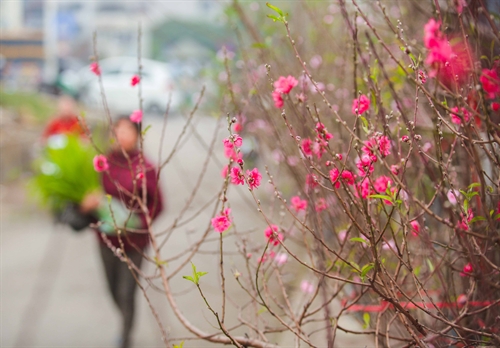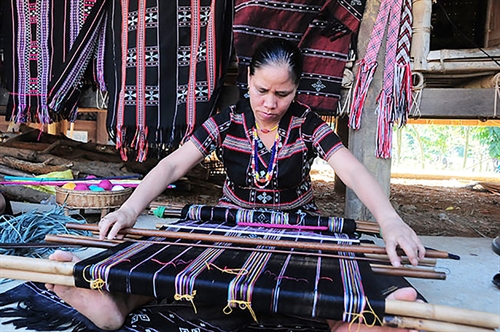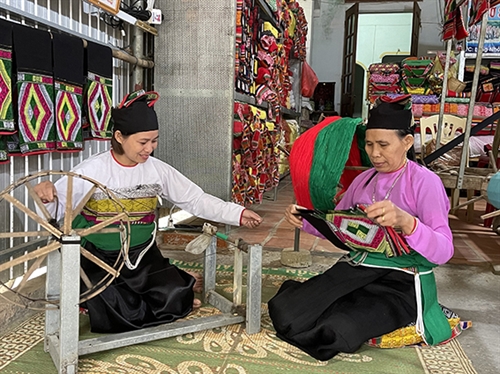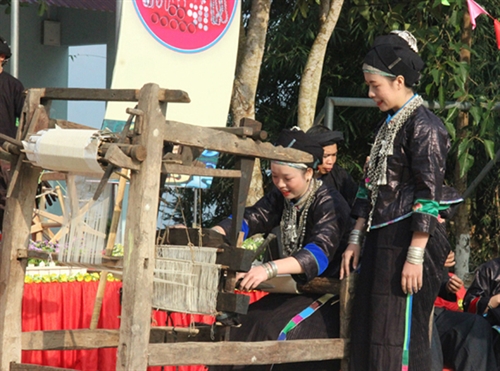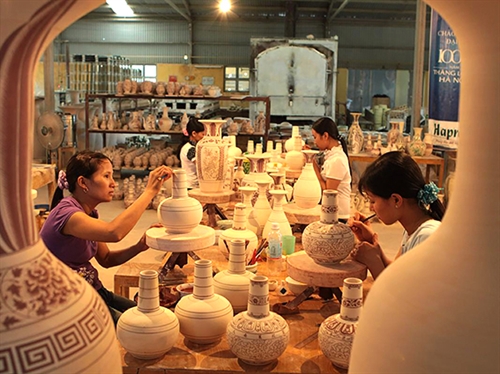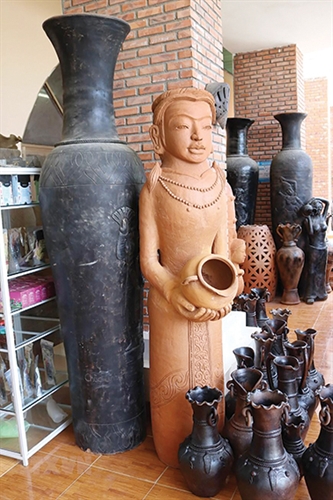According to the Chinese Zodiac, 2022 is the Year of the Tiger. Of the 12 animals named for the lunar year, tiger, symbolizes strength. The image of tigers often appears on the screen placed in the middle, outside or inside the communal house (dinh) of a village. Communal houses, temples and shrines are often built in the position of long ho hoi (dragon and tiger meet), or long chau ho phuc (lying dragon and crouching tiger), or ta thanh long, huu bach ho (green dragon on the left, white tiger on the right) because dragon symbolizes power while tiger represents the ruler of the earth who can expel evil spirits. Many village festivals in the northern delta have rituals involving tiger, the animal regarded as king of the forest.
Ai Lao performance in Giong festival
Giong festival in Phu Dong village, Hanoi, is one of the biggest festivals in the northern delta, held in memory of legendary hero Saint Giong, one of the four immortal figures in Vietnamese folk beliefs. The core of this festival, which is held annually from the 6th to 12th of the fourth lunar month, is a ritual demonstrating the glorious feat of arms of Saint Giong in defeating Yin invaders and defending the country. This ritual includes a tiger dance performed by villagers of Hoi Xa, a village on the southern bank of Duong river which worships Hoang Ho (tiger king) who was a legendary military general of Saint Giong in the fight against foreign enemy. Hoi Xa dragon dancers are organized in a troupe called Ai Lao.
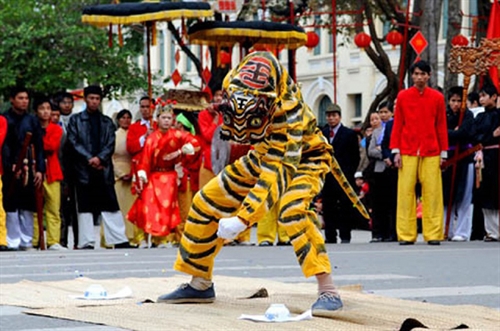 |
| Tiger dance in Giong festival__Photo: Internet |
Before the 1945 August revolution, Hoi Xa village each year nominated a giap (a society of male villagers) to join Giong festival. This giap selected at least 20 young men to join Ai Lao troupe and nominated a troupe head who must be a prestigious elderly person conversant with village customs. A troupe member was designated to masquerade as a tiger and another to act as the master carrying a wooden firearm while the remaining played small drums, gongs, co lau (pennants made of green and red paper fringes and bamboo sticks) and bamboo castanets in the dance.
In the communal house of Hoi Xa was placed a tiger head made of carton and cloth which was worshiped as a deity. On the 15th of the third lunar month, Ai Lao troupe members must be present in the communal house to receive this tiger head. They bought a big piece of cloth which was then dyed yellow, painted with black spots and made into an imitation tiger fur. The tiger dancer would wear the tiger head and fur in a sacrifice dance. After the festival, the giap conducted an offering ceremony at the communal house and burnt the tiger fur while the tiger head was returned to the communal house keeper for use in the next festival.
From the 15th of the third lunar month to the 5th of the fourth lunar month, Ai Lao troupe had to practice singing and dancing, beating rhythms with bamboo castanets.
During the festival, Ai Lao troupe, which sang songs and performed sacrifice dances, always led processions. Led by two signalmen (called tieu co), the troupe processed in the following order: Hoang Ho accompanied by two signalmen beating time in two sides led the troupe, followed by troupe members carrying gongs, firearms and co lau, then 12 others with castanets in two lines and finally a fisherman. Hoang Ho, the symbol of earthy strength, reigned the earth and expelled evil spirits while the fisherman symbolizing the water world drove out water devils. Hoang Ho and the fisherman were the combination of the earth and water to assist Saint Giong in the fight.
In the afternoon of the ninth day of the fourth lunar month, the big battle of Saint Giong was demonstrated, including a tiger dance performance in which a powerful tiger appeared to surrender Saint Giong and joined him in the big battle with Yin invaders.
Gia La, a tiger catching festival
Gia La, a big and well-know festival of Y La and La Noi villages west of Hanoi (now Duong Noi ward, Ha Dong district, Hanoi), is celebrated to honor Duong Canh Cong, a legendary hero who killed tigers and saved Y La and La Noi villagers. The festival, held from the 6th to 14th of the first lunar month in years of bumper crops, has a formality to turn off lights in the closing night of the festival for the performance of the tiger killing tale.
According to legend, under the reign of the 17th Hung King, Tu Liem district suffered major human and property loss caused by tigers. Due Vuong Hung King sent messengers nationwide to look for talents to kill tigers. Duong Canh Cong from La village went to Viet Tri capital, asking for the king’s permission to lead 5,000 hunters to kill tigers. Under his direction, flocks of tigers were killed. The only left was a yellow-mouth roan tiger which hid deep in the forest. With the help of his two fairy wives, Tuyen Nuong and Chinh Nuong, who knew well forests, Duong Canh Cong went to the tiger’s den deep in the forest and finally caught it in Dai La. The tiger was killed for offering to the king and treating hunters. Its fur was used to cover the throne while its tusk was made into a sword hilt. The tiger was buried in front of La Ca village, called Dong Hum (tiger heap). After Duong Canh Cong died, he was elevated into the tutelary god of La Ca village and was honored in Gia La festival.
The festival includes a procession during which the fur of the legendary yellow-mouth roan tiger was placed on a palanquin. In the 14th night of the first lunar month, the tale “Duong Canh Cong kills tiger” is performed in the communal house of La Ca village. An imitation forest made of coconut leaves is placed on the stage. In the forest is a yellow-mouth roan tiger played by a man wearing the tiger fur. Voices of birds, chickens and deer created by 4-6 performers resound in the forest where dancers are playing clubs to snare the tiger. On the left side of the forest is a male singer and on the right side, a female singer.
Beginning the performance, lights in the communal house are turned off. Singers of Dong Tru theatrical troupe sing and dance in harmonious musical sounds while dancing club players lure the tiger. The forest resounds the voices of birds, deer, chicken and gibbons. After two times of singing by the two singers on the two sides of the stage, hunters with torches and bows appear in the sounds of drums, wooden bells, horns and shouts of villagers. After the third time of singing by the female singer, lamenting about the disaster caused by tigers, drum beats and music rise. Two men with clubs in their hands dance in front of the forest, luring the tiger out. Then come drum beats and shouts followed by the male singer’s singing, urging the hunters to catch the tiger. After this singing, drum beats rise again together with shouts. The fight between the tiger and hunters begin before the excitement of thousands of watching villagers. The tiger is injured and then caught by hunters. Villagers vie with one another to tear off the tiger fur to get a piece for luck. After the fight, hunters come back to the stage and the lights are on again.
La Ca festival reflects the people’s fight against wild animals and praise the strength of humans who can defeat such a powerful animal as tiger. Hovever, over the last few years, tiger catching is no longer practiced.-
